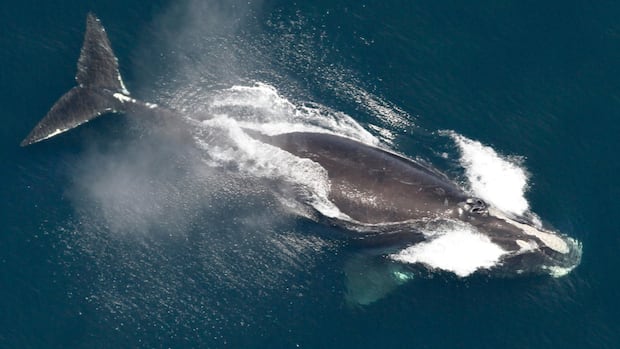In recent years, efforts to protect the endangered North Atlantic right whale population have included making ships slow down in known whale zones to avoid hitting them and encouraging fishing crews to use ropeless gear to prevent them from becoming entangled.
But changes to where the whales congregate have been challenging some of those efforts.
Now scientists at the University of Maine and the New England Aquarium in Boston are working together to improve their modelling to predict where the whales will be at any given time.
“North Atlantic right whales utilize a lot of the ocean environment, and so it’s really hard for humans to be out there observing them at all times,” Camille Ross, an associate research scientist at the New England Aquarium in Boston, said in a radio interview with CBC New Brunswick’s Shift.
“And so models like this are really important to fill in those data gaps when we don’t have eyes on the water.”
Ross is the lead author of the study, called “Incorporating prey fields into North Atlantic right whale density surface models,” which was published in the latest edition of the research journal Endangered Species Research.
A description of the research on the U.S. National Marine Fisheries Service website says there are only about 370 of the endangered whales remaining in the world. Of those, about 70 are females of reproductive age — 10 years and older.
Ross said the whales are moving to different areas to adapt to a changing ocean, so the models have to be able to predict where new feeding habitats are located too.
“Then we can send teams out there to go look for the whales and have potential to discover where they might be going and put conservation measures in place before there are further mortalities,” she said.
Tracking zooplankton
The modelling focuses on types of tiny zooplankton that whales feed on, primarily calanoid copepods. Ross and other scientists went back through past studies looking at what scientists estimated to be the minimum amounts of prey the whales need to ingest per day, to predict where whales would travel based on sufficient food sources.
We end up with this pretty comprehensive image of where prey might be in the Northwest Atlantic.— Camille Ross
Ross said zooplankton sampling programs have been going on for decades, which is helpful in their studies. The research team then uses statistical algorithms for the areas not covered by existing zooplankton studies to fill in the gaps.
“So we end up with this pretty comprehensive image of where prey might be in the Northwest Atlantic,” Ross said.
There is room for improvement, she said, and new studies will be drawn in as they are generated to further update their models.
“If we have some sort of representation of the food that they’re going after, we have a better shot of accurately predicting where they might show up,” she said.
The models are only as good as the underlying data, Ross noted.
“So we need to continue to have teams out in the field observing these animals and collecting data that can then inform models, especially with a shift in climate where we know that these animals might not stay in the same patterns that they have been.”

Matt Abbott, the Fundy Baykeeper and Marine Program Director with the Conservation Council of New Brunswick, said the research was important.
“A study like this can give better information to decision-makers to work collaboratively with the shipping industry, fishery and others to limit our impacts, to reduce — and in some ways, in terms of entanglements and ship strikes, hopefully eliminate — some of those impacts on the right whales,” Abbott said.
“The population [is] so low that individuals count, especially breeding females.”
He said it’s become increasingly rare within the last 15 years to see right whales in the Bay of Fundy.
“We used to have concentrations in the Bay of Fundy, up until the last decade or so, where just the ecology of the bay, the wildlife in the bay wasn’t meeting their needs,” he said. “And so they had to go elsewhere to look for it.”







